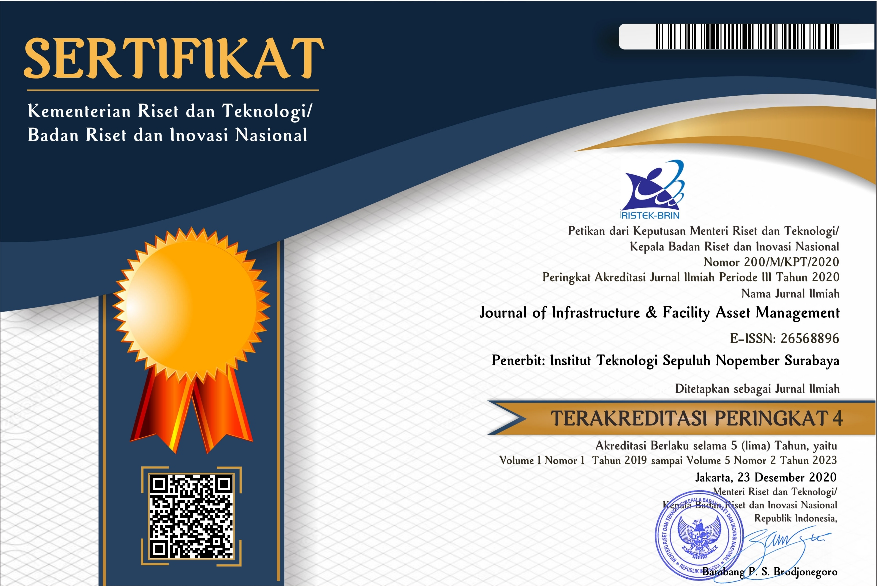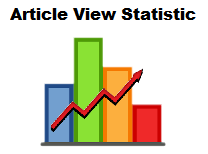Potential Number of Passenger and Performance Evaluation of Surabaya School Bus
Abstract
Surabaya school bus is one of public facilitiesassetsand itsperformance should be evaluated periodically. Because the school bus is a public asset, it necessary to process the facility asset management to maintain operational performance optimally and efficiently. The number of students who use the school bus declines from year to year. Therefore, it’s necessary to study the current performance of school buses and the number of potential students who can use the Surabaya school bus. The method used to survey the number of students utilizing school buses and to conduct school bus performance research. School bus itinerary starts from Dukuh Menanggal Street down to Dharmahusada Indah Street and back to Dukuh Menanggal Street. There are 43 schools along the school buses route. Travel time observed was 1 hour and 10 minutes. The load factoraverage of the 1stschool bus in segment 1 (Dukuh Menanggal - RSI) is 78.67% while in segment 2 (RSI - SMKN 5) it reaches 96%. The load factoraverage of 2nd school bus for segment 1 reach 31.33% and for segment 2 reach only 8%.The total number of students from 11 schools was 12,391 students. However, the number of passengers/day was only 38 students from the operational of two school buses. This indicates that many students were still reluctant to use school buses, so that school bus performance improvements are needed to attract high school and junior high school students.
Full Text:
PDFReferences
Abubakar, Iskandar (1996). Menuju Lalu Lintas Dan Angkutan Jalan Yang Tertib. Direktorat Jenderal Perhubungan Darat. Jakarta.
Danylo, N.H. & Lemer, A. (1998). “Asset Management for the Public Works Manager: Challenges and Strategies”. Findings of the APWA Task Force on Asset Management, APWA, Washington, DC.
Departemen Perhubungan Republik Indonesia (2002). “Pedoman Teknis Penyelenggaraan Angkutan Penumpang Umum di Wilayah Perkotaan Dalam Trayek Tetap dan Teratur”
Dirjen Perhubungan Darat SK 967/A.J.202/DRJD/2007 tentang Pedoman Teknis Penyelenggaraan Angkutan Sekolah.
Kusuma (2015). “Evaluasi Program Bus Sekolah di Kota Surabaya”. Jurnal Kebijakan dan Manajemen Publik. Vol. 3, No. 2, Hal.: 1-7. Sidoarjo.
LPKM-ITB (1997). Modul Pelatihan Perencanaan Sistem Angkutan Umum (Public Transport System Planning). LPKM-ITB.Bandung
Minister of Public Woks Regulation (2014). “Minister of Public Woks Regulation Number: 03/PRT/M/2014, PedomanPerencanaan, Penyediaan, dan PemanfaatanPrasarana dan Sarana Jaringan Pejalan Kakidi Kawasan Perkotaan”
Morlok, E.K. (1995). Pengantar Teknik dan Perencanaan Transportasi. Penerbit Erlangga. Jakarta.
Sekartadji, R., Widyastuti & W. Herijanto (2015). “Study Demand and Supply Bus Sekolah Rute Dukuh Menanggal – SMA Kompleks Surabaya”. Seminar Nasional Sains dan Teknologi Terapan. Vol. III, Hal. 781-788.
Soemitro, R.A.A., & Suprayitno, H. (2018). “Pemikiran Awal tentang Konsep Dasar Manajemen AsetFasilitas”. Jurnal Manajemen Aset Infrastruktur & Fasilitas, Vol. 2, Sup. 1, 2018.
Tamin, O.Z. (2000). Perencanaan dan Pemodelan Transportasi. Penerbit ITB. Bandung.
Warpani, P.S. (1990). Merencanakan Sistem Perangkutan. Bandung: Penerbit ITB
World Bank (1986). The International World Bank for Reconstruction and Development, Urban Transport. Washington.
DOI: http://dx.doi.org/10.12962%2Fjifam.v1i2.5972
Refbacks
- There are currently no refbacks.
Visitor :
Flag Counter

Journal Of Infrastructure & Facility Asset Management by Institut Teknologi Sepuluh Nopember is licensed under a Creative Commons Attribution-ShareAlike 4.0 International License.





